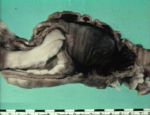Intussusception
Revision as of 19:22, 6 June 2010 by Bara (talk | contribs) (Text replace - 'Intestine Diarrhoea - Pathology' to 'Diarrhoea')
- Telescoping of one segment of the bowel into another.
- Occurs in all species.
- Particularly in young dogs.
- Can occur in the small intestine, caecum or colon.
Clinical
- Intussusception is a less acute type of obstruction.
- Produces intermittent diarrhoea.
- Animals go downhill in a few days.
- Palpation of abdomen may allow a "Cumberland sausage" effect to be felt.
- NB abdominal palpation in small animal, rectal palpation in large animal.
Pathogenesis
- Proximal intestine invaginates into lower part of intestine.
- Takes mesenteric attachment with it.
- Compression of the mesenteric vessels obstructs venous drainage of the gut, resulting in venous congestion.
- Swelling (oedema/congestion) arises.
- Inflammatory exudate from serous surface.
- Fibrinous adhesions form between surfaces making structure irreducible.
- Inflammatory exudate from serous surface.
- Swelling (oedema/congestion) arises.
- May progress to necrosis and gangrene of the tissue.
- There is often functional obstruction to bowel.
- May rupture, leading to peritonitis and death.
- Associated with anything that raises peristalsis e.g. change in diet, bacterial infection.
- Foreign body
- Intramural abscess/tumour
- Heavy parasitism
- Previous intestinal surgery
- Enteritis
- Other motility disorders.
- Change in diet
- Bacterial infection
Pathology
- When operate or at post mortem see large sausage shaped distension of length of intestine.
- Intussusception may occur post mortem
- There are no associated changes
- The condition is easilt reducible.

